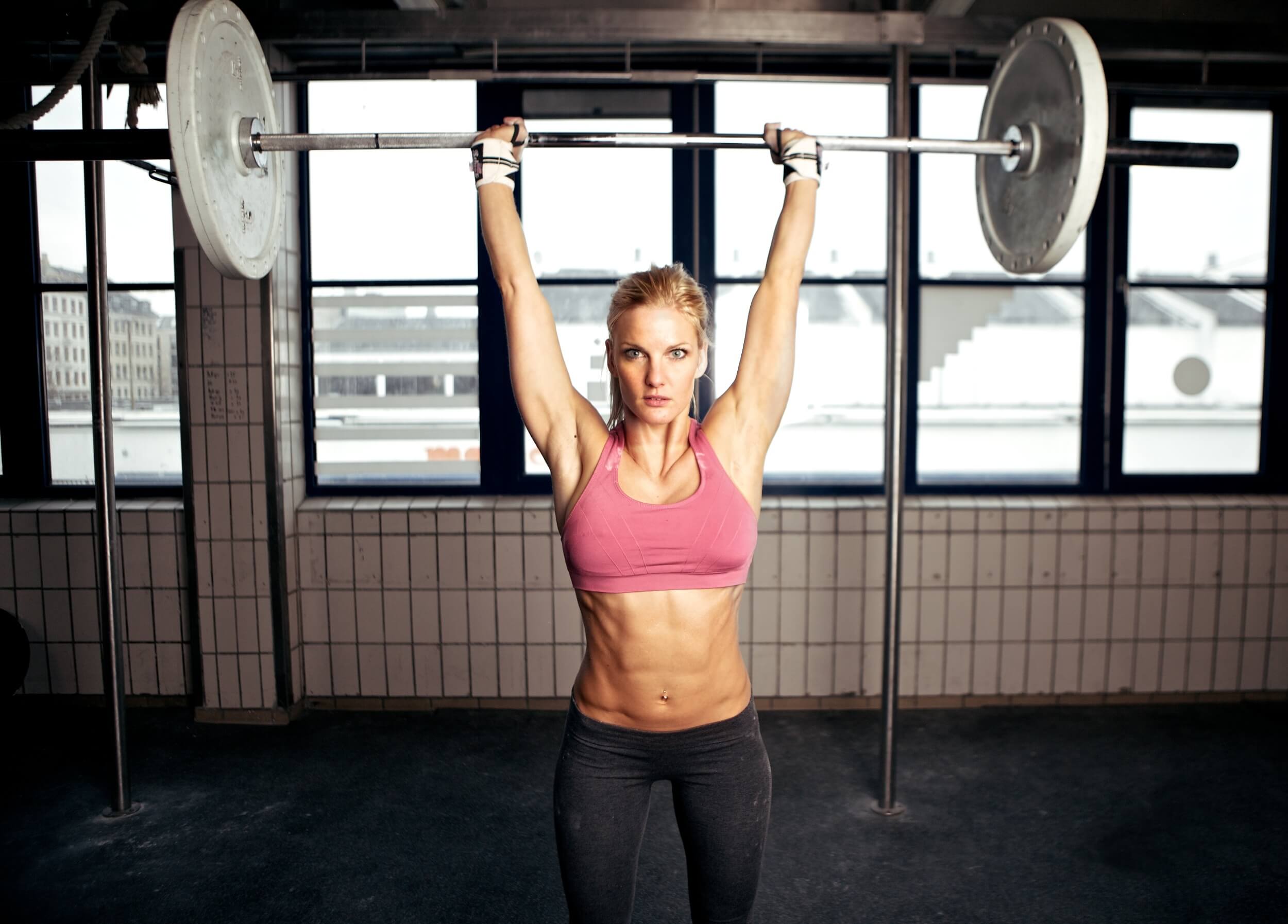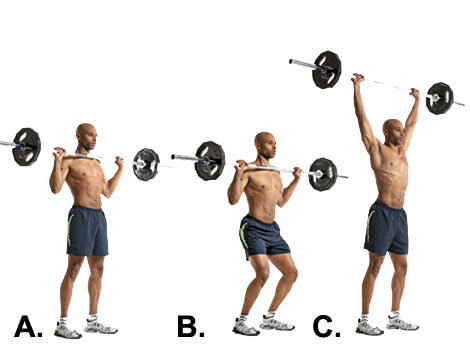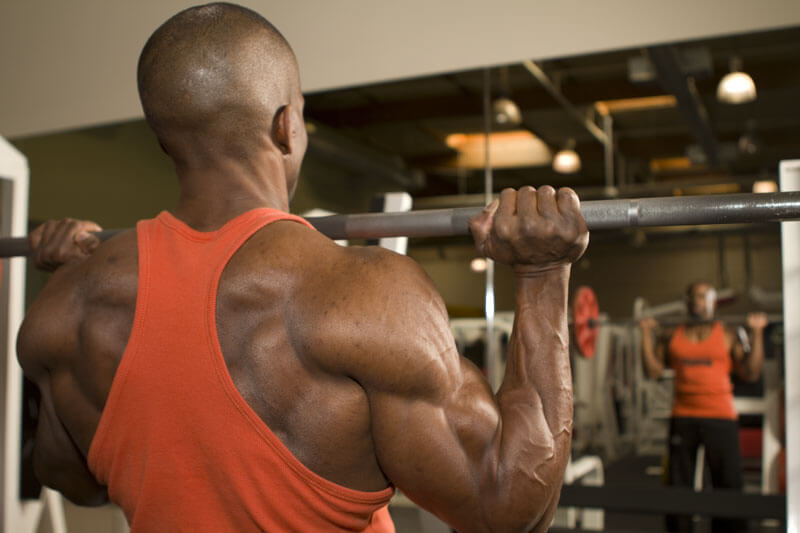The clean and jerk are one of the greatest all-around exercises on the planet. It is a multi-combo move that brings together a deadlift with a barbell push press.
Maybe you’re not big on the giant combo move thing.
Or perhaps you like to send your deadlift over to leg day and would like the upper body portion to be on upper body day.
Whatever your reasoning, the push press is a great exercise to bring into your workout. Of course, while we mentioned the barbell, there are plenty of other ways you can go about performing the routine.
We’ll fill you in on all the different ways to perform the push press and all the other goodies you need to know about it.
Just keep on reading!
What is the Push Press
The push press is a move very similar to a shoulder press or military press.
The traditional push press though is done with a loaded barbell. The barbell begins right above shoulder level. You press the barbell up, above your head until the weight is fully above the head and your arms are nearly straight. From there, the barbell is lowered back down to the starting position.
The move itself is rather straightforward (step by step instructions a little further on down), but it is a power move and great for building explosive strength and performance.
Ideally, the move is also performed using free weights such as a barbell, although when this is not an option there are other methods available.
How to Perform a Push Press
The best way to perform a push press, especially when just starting out, is to take advantage of a loading rack at the gym.
This way, should something happen with the weights, it is there to catch the barbell.
The loading barbell should be positioned on the loading rack slightly under shoulder height. From here, you are able to move under it with a slight squat and push yourself into the weight as you free it from the loading rack.
Stand up and make sure you keep your back straight. Position your legs about shoulder width apart while the barbell runs across the top of your chest and along your shoulders. You want your palms to be under the barbell so your forearms are pointed away from you.
From this position, explode up with the weight, pushing the barbell up over your head.
Exhale during this part of the move as you push out you’re breathing at the same time as pushing the weight away from your body. This should be a very fast, fluid motion. It’s not a slower paced press but instead one that maximizes the momentum of your explosive move. You may extract some power from your knees as you push up through your lower body, but don’t try to squat and press up. The majority of the exercise power comes from your upper body.
Inhale as you bring the bar back down to the starting position.
You should flex your knees and hips slightly as you lower the weight back down. This is the completion of a single rep.
Muscles Targeted
This is a shoulder exercise through and through.
The deltoid muscle is the main focus of the workout, although you do hit the pectoralis minor muscle a bit during the left as well.
On top of this, you’ll work the infraspinatus muscle and the teres minor muscle, both of which are on the back of the shoulder.
Overall though, this is a shoulder defining exercise, so if you’re looking to build size and strength with the shoulder, the push press is right for you (Inner Body, 2017).
Wait, Isn’t This Exactly Like the Shoulder Press?
As you read through the push press, what it works and how it is performed, you may start to think this doesn’t just sound a bit like the shoulder press, it sounds exactly like the shoulder press.
Well, in a way, you’re right.
Think of the push press as a step up from the shoulder press.
With the shoulder press, you use typically either dumbbells or a machine. You push it up in the same manner and target the same muscles.
However, you can eventually lift more weight with the push press than you can with a traditional shoulder press.
With a shoulder press, you use a concentric, stationary movement, that relies completely on your shoulders to push up on the weight. There is a limit to the amount of weight you can push up with this. If you have been workout your shoulders for a while now or are a heavyweight lifter, you will find you maximize the weight you can lift with a shoulder press and, no matter how you train it, you just can’t put up anymore.
Now, you can go lighter and shoot for more reps, but you may see this as a step backward.
When this happens, the push press is able to assist.
The push press begins with the initial push up through the lower body. While it’s not moving from a squat into the press, the energy generated from the simple lower body push moves through the upper body and allows for a more explosive move, which in turn allows for the lifting of the weight.
Think of it as almost revving up an engine. Instead of going from a cold engine, the engine is already revved and fired up, which allows it to get off the line faster.
With the push press, the energy generated from the lower body is transferred into the upper body, allowing you to not only lift the weight, but you can lift more weight using the push press than with a standard shoulder press (ExRx, 2017).
With the ability to lift more through a push press, you may decide to move from the shoulder press to the push press if you are not seeing the kind of strength results you’d like any longer.
Naturally, by increasing the amount of weight you can lift on the push press, you’ll not only see size and performance improvements with your shoulders, but it should in turn help boost the performance of your bench and other upper body lifts as well.
I Haven’t Trained My Shoulders, Should I Go Directly Into The Push Press?
Now here is where it gets a bit tricky and where we might want to back off of the push press a little bit.
The reason here is because you’re generating initial power and thrust from the lower body, the very first stage of the lift performed with the upper body may become underdeveloped. Essentially, your lower body allows you to “cheat” with this move in order to push your way to the top of the move. If you haven’t trained your shoulders directly, you’ll do yourself a disservice by not training the beginning portion of the lift, which is crucial for developing shoulder strength.
Due to the potential for under developing the first portion of the lift, it is generally recommended to start out on a shoulder or military press.
As you do not rely on the lower body at all to perform the lift, you’ll ensure you completely develop the entire area of the body. Because both lifts focus on the shoulders when first starting off you likely will not max out the potential weight you can lift initially. So, you should really begin with one of the other lifts before moving up (or “graduating” to the push press).
I’ve Maxed Myself Out on the Shoulder Press, I should Just Stick with the Push Press, Right?
Again, we get a bit tricky here.
So you’ve maxed yourself out with the shoulder press.
Or, at the very least, you are not seeing the kind of gains you’d like any longer, so you’re thinking about making the switch to the push press. Using the push press is a great tool for boosting your performance and strength.
However, it doesn’t mean you should completely skip out on the shoulder and military press either.
As we covered, with the push press you may not fully train the initial stage in the lift. If you make the complete move over to the push press, you run the risk of not fully hitting this area of the lift and exposing yourself to possible drops in strength. You may not see the drop of strength in the push press, but it could affect other lifts you perform.
Due to this, you may want to alternate between the push press and your shoulder press, just to make sure you maintain the level of performance for that first stage of the lift.
So on one upper body day (or push day, if you break up your workouts into push/pull days), bring in the push press. On your next day, switch back to the shoulder press.
Or, at the very least, do it once every three upper body/push workout days, just so you at least maintain your strength level (Barbend, 2017).
Who Shouldn’t Perform the Push Press At All
The push press is a great exercise, although it may not be right for everyone.
If you have suffered a shoulder injury or have had any kind of rotator cuff issues, this might not be the best lift for you.
Additionally, if you are suffering from elbow problems, again you’ll want to steer clear from this kind of a workout.
Outside of suffering from any kind of injury, this is an exercise you need to at the very least tryout and see how you like it.
Reps and Sets
So, realistically, if you’re making the move over to the push press, you’re going for an increase in strength.
You’ve maxed out your shoulder press and want to continue building strength. If this is the case, you’ll want to pump out 4 reps per set. Shoot for 2-3 sets, and realistically put this towards the end of your workout. As you’re working just a small area of the body you don’t want to wear out your shoulders and then not be able to perform for the larger upper body lifts.
On the flip side, if you want to use the push press to develop explosive power, you’ll want to go with a lighter weight. When lifting lighter, shoot for about 12 reps max. If you fall in the 8 or 10 rep range that is fine, but if you’re squeezing out more than 12 reps without a problem than the weight is too light and it isn’t doing you much good at all. When going for explosive power, perform 3 sets.
Combining the Push Press With Other Lifts
Perhaps you’re not a clean and jerk kind of person.
Maybe you like your deadlifts separate from other lifts.
Nothing wrong with this as you can probably deadlift far more than you can actually push up. If you’re fine with combining the two, go lighter and perform the deadlift into a push press. It’s a great total body lift.
Then on your next workout, perform your regular deadlift and combine the push press with your squat. So squat and then explode with the bar from behind your head. It’s the exact same move only instead of pushing in front of your head you’ll push up behind (you may actually find you like this better).
It’s a nice way to combine two different lifts into a single move.
Conclusion
The push press is a great addition to your upper body workout.
As it works your back, shoulders and chest area, it is a solid muscle and strength builder. While it might not be the best option for individuals with shoulder and elbow problems, everyone else should consider it as it helps build functional strength. If you haven’t yet tried out the push press before, now is the perfect time to do it. Just start out light, master the movement (especially if using free weights) and progress from there.
You’ll begin to feel like an Olympic athlete in no time.
-Terry Asher
Terry Asher
Latest posts by Terry Asher (see all)
- Better Family – Product Review Liquid Daily 2 oz - Dec 16, 2024
- Post-Workout Recovery: The Key to Optimal Performance - Nov 25, 2024
- Pre-Workout Supplements – Everything You Need To Know - Nov 18, 2024














[…] via- https://gymjunkies.com/push-press/ […]
Great got many ideas about push press . I was aware of such information described here in such a nice way. Thanks for sharing such an informative post.
Thank you so much for your blog. I’ve been following your tips on what types of a push press to perform and you’ve improved my understanding of fitness goals immensely!
Your blog is really comprehensive. More power